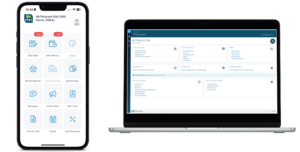Trends in commercial property management to expect in 2024
As 2024 develops, commercial property management continues to evolve, shaped by technological advancements, changing tenant demands and global market shifts. In this fast-paced environment, staying ahead of the curve is crucial for property managers aiming to optimise efficiency, enhance tenant experiences and drive sustainable growth.
In this post, we explore 2024’s top commercial property management trends, from AI integration to smart tech and tips on how to adapt to future-proof your commercial property.
The top 5 commercial property management trends
From the integration of cutting-edge technology to the growing emphasis on sustainability, these trends are transforming how properties are managed and tenants are served.
1. Increasing role of AI in property management software
The increasing integration of artificial intelligence (AI) into commercial property management software is reshaping how properties are managed and tenants are served. AI-powered solutions are revolutionising the way property managers operate by streamlining processes, enhancing data accuracy and delivering a superior tenant experience.
One of the primary advantages of AI in property management software is its ability to facilitate data-led decision-making. By harnessing AI algorithms, property managers can gain deeper insights from vast amounts of data and real estate metrics, enabling them to make more informed decisions. This heightened data accuracy and the ability to analyse large datasets quickly empower property managers to optimise property performance and identify opportunities for improvement with greater precision.
Furthermore, AI-driven automation is revolutionising routine tasks and workflows within property management. By automating tasks such as maintenance requests, scheduling, rent collection and reminders, AI-powered systems save valuable time and resources while significantly improving efficiency and productivity. This automation not only reduces the administrative burden on property managers but also ensures that essential tasks are completed promptly and accurately, contributing to smoother operations and better tenant satisfaction.
The integration of AI also enables property managers to deliver a more personalised experience to tenants. By leveraging AI-driven chatbots for 24/7 customer support, property managers can provide tenants with immediate assistance, enhancing their overall experience. Additionally, AI allows for the customisation of services and communications based on individual tenant preferences and behaviour, fostering stronger tenant relationships and loyalty.
2. Demand for predictive maintenance
The demand for predictive maintenance in commercial property management is on the rise, driven by its ability to revolutionise how maintenance is managed and optimise property performance. This data-driven approach leverages sensors and advanced data analysis to anticipate potential issues, enabling property managers to address them proactively before they escalate into costly repairs or disrupt tenant operations.
Predictive maintenance holds immense benefits for both property managers and tenants alike. For tenants, swift resolutions to maintenance issues translate into an enhanced experience, as they can rely on uninterrupted operations, reduced downtime and timely resolutions to their concerns. Property managers no longer need to deal with reactive maintenance headaches, as predictive maintenance not only minimises the risk of major problems but also prolongs the lifespan of assets, saving time and resources in the long run.
3. Importance of sustainability remains
The importance of sustainability in commercial property management continues to be paramount in 2024. Sustainable buildings and assets not only reduce operating costs by optimising energy, water and waste management but also contribute to a healthier environment by minimising carbon footprint and conserving natural resources, such as through the implementation of solar panels and other green energy generation initiatives.
Moreover, sustainable practices align with global initiatives to achieve Net Zero and Environmental, Social, and Governance (ESG) targets, driving the adoption of certifications such as BREEAM and LEED. Governments worldwide are incentivising sustainable practices in commercial real estate through regulations, certifications and potential tax benefits, further encouraging property managers to prioritise sustainability in their operations.
4. Tenant desire for space flexibility
In 2024, tenant demand for space flexibility continues to shape the commercial property sector. Businesses are increasingly seeking adaptable office space arrangements that align with fluctuating business needs and evolving work patterns. This includes the desire for the option to scale office space up or down swiftly, reflecting changes in business conditions or office attendance rates.
Tenants are also prioritising flexibility in the configuration of office layouts. There’s a growing preference for more communal areas to foster collaboration and social interaction, as opposed to traditional setups dominated by private offices. Additionally, tenants seek the ability to customise and subdivide spaces like conference rooms to accommodate diverse meeting formats and team sizes.
By offering adaptable and customisable office environments, property managers and landlords can meet the dynamic needs of modern businesses and create spaces that support productivity, collaboration and employee well-being.
5. Wide adoption of smart building technologies
In 2024, the widespread adoption of smart building technologies is transforming commercial property management, aligning with the growth of smart cities worldwide. These advanced systems empower property and facilities managers to oversee properties remotely, accessing and monitoring crucial real-time building data around the clock. This capability enhances responsiveness and efficiency in addressing building conditions and tenant needs.
Key components of smart building technologies include sensors and thermostats, which optimise lighting and temperature based on usage patterns. By targeting adjustments only to rooms that require them, such as turning off lights in vacant areas, property managers achieve significant energy cost efficiencies. Moreover, these systems contribute to improved predictive maintenance by detecting and addressing potential issues before they escalate.
Smart technologies also create a flexible work environment by monitoring occupancy levels and providing insights into space utilisation. This data-driven approach enables property managers to enhance space usage and adapt layouts to evolving needs effectively. Additionally, by monitoring indoor air quality, temperature and humidity levels, smart building technologies boost occupant comfort and well-being.
Furthermore, smart security solutions with remote monitoring and access control enhance building security, increasing occupants’ safety and peace of mind.
How to embrace future trends in commercial property management
By embracing these trends in commercial property management, property managers can position themselves for success in a rapidly evolving market, driving efficiency, sustainability and tenant satisfaction to new heights.
- Embrace technology integration: Invest in property management software that incorporates AI, IoT and smart building technologies to streamline operations, enhance efficiency and improve tenant experiences. Stay updated with emerging technologies and be willing to adapt to stay ahead of the curve.
- Prioritise sustainability initiatives: Implement sustainable practices such as energy-efficient upgrades, waste reduction strategies and green certifications to minimise environmental impact and meet evolving regulatory standards. Explore opportunities for renewable energy integration and eco-friendly building materials to create more sustainable properties.
- Foster flexibility in space design: Design office spaces with flexibility in mind, incorporating adaptable layouts and communal areas to meet the changing needs of tenants. Embrace agile workspace concepts that allow for easy scaling up or down and encourage collaboration and innovation.
- Invest in predictive maintenance: Adopt predictive maintenance strategies leveraging data analytics and IoT sensors to anticipate and address maintenance issues before they escalate. Proactively schedule preventive maintenance tasks to minimise downtime, reduce repair costs and prolong asset lifespan.
- Enhance tenant engagement: Prioritise tenant satisfaction by leveraging technology to offer personalised services, streamlined communication channels and responsive support. Gather feedback regularly and implement tenant-driven improvements to create a positive and engaging tenant experience.
FAQs about commercial property management trends
How ScotRail has streamlined portfolio management with MRI Horizon
ScotRail, the publicly owned Scottish railway network operator, selected MRI Horizon to manage its rental and lease portfolio, comprising 220 units across 356 stations. Business challenge The decision to deploy MRI Horizon was part of ScotRail’s digi…

